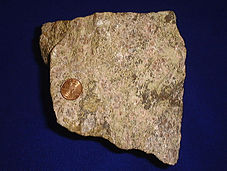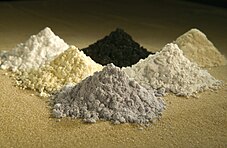The rare-earth elements (REE), also called the rare-earth metals or rare earths, and sometimes the lanthanides or lanthanoids (although scandium and yttrium, which do not belong to this series, are usually included as rare earths),[1] are a set of 17 nearly indistinguishable lustrous silvery-white soft heavy metals. Compounds containing rare earths have diverse applications in electrical and electronic components, lasers, glass, magnetic materials, and industrial processes.
Scandium and yttrium are considered rare-earth elements because they tend to occur in the same ore deposits as the lanthanides and exhibit similar chemical properties, but have different electrical and magnetic properties.[2][3] The term 'rare-earth' is a misnomer because they are not actually scarce, although historically it took a long time to isolate these elements.[4][5]
These metals tarnish slowly in air at room temperature and react slowly with cold water to form hydroxides, liberating hydrogen. They react with steam to form oxides and ignite spontaneously at a temperature of 400 °C (752 °F). These elements and their compounds have no biological function other than in several specialized enzymes, such as in lanthanide-dependent methanol dehydrogenases in bacteria.[6] The water-soluble compounds are mildly to moderately toxic, but the insoluble ones are not.[7] All isotopes of promethium are radioactive, and it does not occur naturally in the earth's crust, except for a trace amount generated by spontaneous fission of uranium-238. They are often found in minerals with thorium, and less commonly uranium.
Though rare-earth elements are technically relatively plentiful in the entire Earth's crust (cerium being the 25th-most-abundant element at 68 parts per million, more abundant than copper), in practice this is spread thin across trace impurities, so to obtain rare earths at usable purity requires processing enormous amounts of raw ore at great expense, thus the name "rare" earths.
Because of their geochemical properties, rare-earth elements are typically dispersed and not often found concentrated in rare-earth minerals. Consequently, economically exploitable ore deposits are sparse.[8] The first rare-earth mineral discovered (1787) was gadolinite, a black mineral composed of cerium, yttrium, iron, silicon, and other elements. This mineral was extracted from a mine in the village of Ytterby in Sweden; four of the rare-earth elements bear names derived from this single location.
- ^ The 1985 International Union of Pure and Applied Chemistry "Red Book" (p. 45) recommends that lanthanoid is used rather than lanthanide. The ending "-ide" normally indicates a negative ion. However, owing to wide current usage, "lanthanide" is still allowed and is roughly analogous to rare-earth element.
International Union of Pure and Applied Chemistry (2005). Nomenclature of Inorganic Chemistry (IUPAC Recommendations 2005). Cambridge (UK): RSC–IUPAC. ISBN 0-85404-438-8. p. 51. Electronic version. - ^ Cite error: The named reference
ASella2016was invoked but never defined (see the help page). - ^ T Gray (2007). "Lanthanum and Cerium". The Elements. Black Dog & Leventhal. pp. 118–122.
- ^ "Rare earths: Neither rare, nor earths". BBC News. March 23, 2014. Retrieved April 19, 2023.
- ^ Lee, Jordy. "Rare Earths Explained". Milken Institute Review. Retrieved April 19, 2023.
- ^ Huang, Jing; Yu, Zheng; Chistoserdova, Ludmila (June 26, 2018). "Lanthanide-Dependent Methanol Dehydrogenases of XoxF4 and XoxF5 Clades Are Differentially Distributed Among Methylotrophic Bacteria and They Reveal Different Biochemical Properties". Frontiers in Microbiology. 9: 1366. doi:10.3389/fmicb.2018.01366. PMC 6028718. PMID 29997591.
- ^ Malhotra, Nemi; Hsu, Hua-Shu; Liang, Sung-Tzu; Roldan, Marri Jmelou M.; Lee, Jiann-Shing; Ger, Tzong-Rong; Hsiao, Chung-Der (September 16, 2020). "An Updated Review of Toxicity Effect of the Rare Earth Elements (REEs) on Aquatic Organisms". Animals. 10 (9): 1663. doi:10.3390/ani10091663. ISSN 2076-2615. PMC 552131. PMID 32947815.
- ^ Haxel G.; Hedrick J.; Orris J. (2002). Peter H. Stauffer; James W. Hendley II (eds.). "Rare Earth Elements—Critical Resources for High Technology" (PDF). United States Geological Survey. USGS Fact Sheet: 087-02. Archived (PDF) from the original on December 14, 2010. Retrieved March 13, 2012.
However, in contrast to ordinary base and precious metals, REE have very little tendency to become concentrated in exploitable ore deposits. Consequently, most of the world's supply of REE comes from only a handful of sources, almost entirely as a byproduct of mining other elements in commercially exploitable concentrations they occur alongside.

